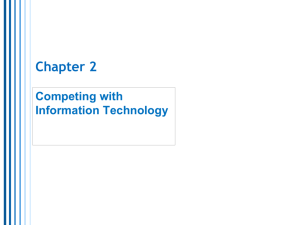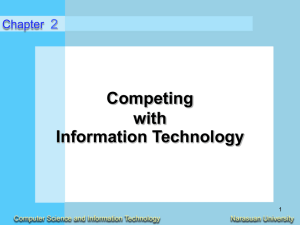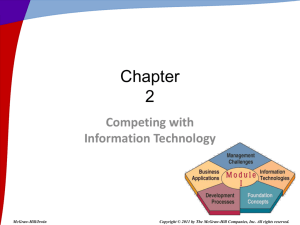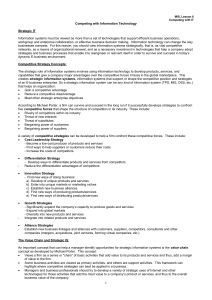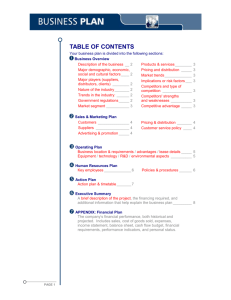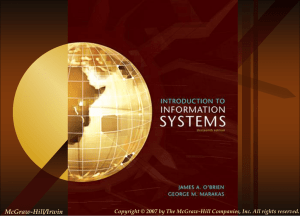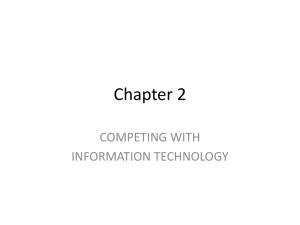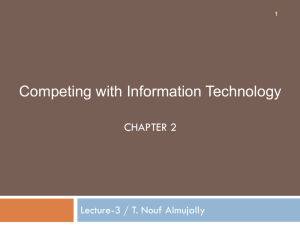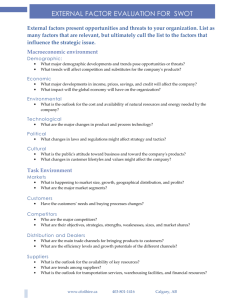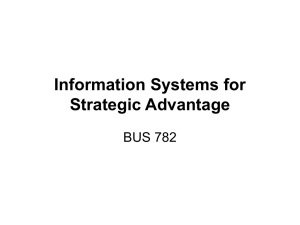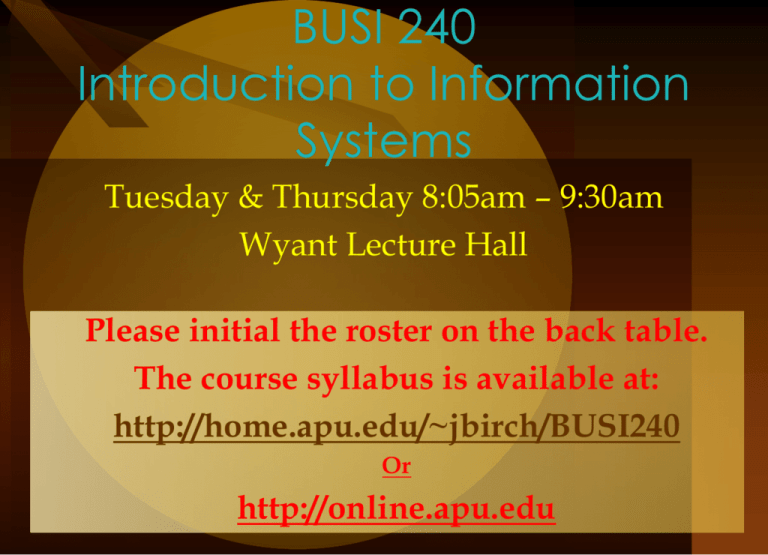
BUSI 240
Introduction to Information
Systems
Tuesday & Thursday 8:05am – 9:30am
Wyant Lecture Hall
Please initial the roster on the back table.
The course syllabus is available at:
http://home.apu.edu/~jbirch/BUSI240
Or
http://online.apu.edu
Chapter
1
Foundations of Information
Systems in Business
Why should you study information systems?
How does a firm use information systems?
What are the components of an information system?
McGraw-Hill/Irwin
Copyright © 2007 by The McGraw-Hill Companies, Inc. All rights reserved.
Why study Information Systems and
Information Technology?
Vital
component of successful businesses
Helps businesses expand and compete
Businesses use IS and IT
To
improve efficiency and effectiveness of business
processes
For managerial decision making
For workgroup collaboration
1-3
What is a system?
A
system
Is
a set of interrelated components
With a clearly defined boundary
Working together to achieve a common set of objectives
1-4
Information System
INPUT
1-5
PROCESS
OUTPUT
Basic Information System
TIMECARD
1-6
PAYROLL
PAYCHECK
What is an Information System?
An
organized combination of
People
Hardware
Software
Communications
networks
Data
resources
Policies and procedures
That
stores, retrieves, transforms, and disseminates
information in an organization
1-7
Information System (IS) versus Information
Technology (IT)
IS
is all the components and resources necessary to
deliver information and functions to the organization
IT is hardware, software, networking and data
management
In
theory, IS could be paper based
But we will focus on Computer-Based Information
Systems (CBIS)
1-8
IS Knowledge Framework for
Business Professionals
1-9
What should a Business Professional
know about IS?
Foundation
Concepts: fundamental behavioral,
technical, business and managerial concepts
Information Technology: Hardware, software,
networks, data management and Internet-based
technology
Business Applications: Major uses of the IS in the
organization
Development Processes: How to plan, develop and
implement IS to meet business opportunities
Management Challenges: The challenges of
effectively and ethically managing IT
1-10
What does IS do for a business?
1-11
Business Applications expanding
role over time
1-12
What is E-business?
The
use of Internet technologies
to
work and empower business processes, electronic
commerce, and enterprise collaboration
within a company and with its customers, suppliers,
and other business stakeholders.
An
1-13
online exchange of value.
How e-business is being used
1-14
E-business use
Reengineer
internal business processes
Enterprise collaboration systems: support
communications, coordination and collaboration
among teams and work groups, e.g., virtual teams
Electronic commerce: buying, selling, marketing and
servicing of products and services over computer
networks
1-15
Types of IS
1-16
Operations support systems
What
are they?
Efficiently
process business transactions
Control industrial processes
Support communications and collaboration
Update corporate databases
1-17
Types of Operations Support
Systems
Transaction
Processing Systems
Record
and process data from business transactions
Examples: sales processing, inventory systems,
accounting systems
Process
Control Systems
Monitor
and control physical processes
Example: in a petroleum refinery use sensors to
monitor chemical processes
Enterprise
Collaboration Systems
Enhance team
and work group communications
Examples: e-mail, videoconferencing
1-18
Two ways to process transactions
Batch
Processing:
Accumulate
transactions over time and process
periodically
Example: a bank processes all checks received in a
batch at night
Online
Processing:
Process
transactions immediately
Example: a bank processes an ATM withdrawal
immediately
1-19
Management Support Systems
What
are they?
Provide
information and support for effective decision
making by managers
1-20
Types of Management Support
Systems
Management
Information Systems (MIS)
Provide
reports and displays to managers
Example: daily sales analysis reports
Decision
Support Systems (DSS)
Provide
interactive ad hoc support for decision making
Example: A what-if-analysis to determine where to
spend advertising dollars
Executive
Provide
Information Systems (EIS)
critical information for executives and
managers
Example: easy access to actions of competitors
1-21
Operational or Management
Systems
Expert
Systems
Provide
expert advice
Example: credit application advisor
Knowledge
Support
Management Systems
creation, organization and dissemination of
business knowledge throughout company
Example: Intranet access to best business practices
1-22
Classifications of IS by scope
1-23
Functional business systems
Focus on operational and managerial applications of basic
business functions
Examples: support accounting, finance or marketing
Strategic information systems
Help get a strategic advantage over its customers
Examples: shipment tracking, e-commerce web systems
Cross-functional information systems
Systems that are combinations of several types of
information systems
Provide support for many functions
Challenges and Opportunities of IT
1-24
Measuring success of an IS
Efficiency
Minimize
cost, time and use of information resources
Effectiveness
Support
business strategies
Enable business processes
Enhance organizational structure and culture
Increase the customer and business value
What’s
the difference between Efficiency and
Effectiveness?
1-25
Developing IS Solutions
1-26
What is a system?
A
system
Is
a set of interrelated components
With a clearly defined boundary
Working together to achieve a common set of objectives
By accepting inputs and producing outputs in an
organized transformation process
1-27
Systems have three basic functions:
1-28
Input involves capturing and assembling elements
that enter the system to be processed
Processing involves transformation process that
convert input into output
Output involves transferring elements that have
been produced by the transformation process to
their ultimate destination
Cybernetic system
All
systems have input, processing and output
A cybernetic system, a self-monitoring, selfregulating system, adds feedback and control:
Feedback
is data about the performance of a system
Control involves monitoring and evaluating feedback
to determine whether a system is moving towards the
achievement of its goal
1-29
A Cybernetic system
1-30
A business as a system
1-31
Information systems model
1-32
Components of an IS
People
End
users: the people who use the IS or the
information from the IS
IS specialists: the people who develop and operate IS
Hardware
Resources
All
physical devices used in information processing
Machines, data media, peripherals
Software
All
Resources
information processing instructions including
programs and procedures
System software, application software and procedures
1-33
Components of an IS (cont.)
Data
Resources
Facts
about the business transactions
Processed and organized information
Databases of organized data
Network
Resources
Communications
media
Network infrastructure: hardware and software
The Internet, intranets and extranets
1-34
Data versus Information
Data
are raw facts about physical phenomena or
business transactions
Information is data that has been converted into
meaningful and useful context for end users
Example:
Sales
data is names, quantities and dollar amounts
Sales information is amount of sales by product type,
sales territory or salesperson
1-35
IS Activities
Input
of data resources
Data
entry activities
Processing
E.g.,
of data into information
calculate, compare, sort, classify, summarize
Output
of information products
Messages,
Storage
Data
reports, forms and graphic images
of data resources
elements and databases
Control
of system performance
Monitoring
1-36
and evaluating feedback
Recognizing IS
As
a business professional, you should be able to
look at an IS and identify
The
people, hardware, software, data and network
resources they use
The type of information products they produce
The way they perform input, processing, output,
storage and control activities
1-37
IT Careers
Outsourcing
of basic programming to India, the
Middle-East and Asia-Pacific countries
Strong employment opportunities in other areas in IS
Shortage of qualified IS personnel
Long-term job outlook positive and exciting
1-38
Career Opportunities in IS
1-39
Job growth
Among
the fastest growing occupations through 2012
Systems
Analyst,
Database administrators,
Other managerial-level positions
Network specialists
Information security
1-40
IS Function represents
Major
functional area of business
Important contributor to operational efficiency,
employee productivity, morale, customer service and
satisfaction
Major source of information and support for effective
decision making
Vital ingredient in developing competitive products
and services in the global marketplace
Dynamic and challenging career opportunity
Key component of today’s networked business
1-41
Ethical challenges of IT applications
1-42
Ethical responsibilities
What
uses of IT might be considered improper or
harmful to other individuals or society?
What is the proper business use of the Internet or a
company’s IT resources?
How can you protect yourself from computer crime?
1-43
Strategic IT
Technology
is no longer an afterthought in forming
business strategy, but the actual cause and driver.
IT can change the way businesses compete.
A strategic information system is
Any
kind of information system
That uses IT to help an organization
2-44
Gain a competitive advantage
Reduce a competitive disadvantage
Or meet other strategic enterprise objectives
Competitive Forces and Strategies
2-45
Competitive Forces
If
a business wants to succeed must develop
strategies to counter these forces:
Rivalry
of competitors within its industry
Threat of new entrants into an industry and its markets
Threat posed by substitute products which might
capture market share
Bargaining power of customers
Bargaining power of suppliers
2-46
Five Competitive Strategies
Cost
Leadership
Become
low-cost producers
Help suppliers or customers reduce costs
Increase cost to competitors
Example, Priceline uses online seller bidding so buyer
sets the price
Differentiation
Develop
Strategy
ways to differentiate a firm’s products from its
competitors
Can focus on particular segment or niche of market
Example, Moen uses online customer design
2-47
Competitive Strategies (cont.)
Innovation Strategy
Find new ways of doing business
Unique products or services
Or unique markets
Radical changes to business processes to alter the fundamental
structure of an industry
Example, Amazon uses online full-service customer systems
Growth Strategy
Expand company’s capacity to produce
Expand into global markets
Diversify into new products or services
Example, Wal-Mart uses merchandise ordering by global
satellite tracking
2-48
Competitive strategies (cont.)
Alliance
Strategy
Establish
linkages and alliances with
Customers, suppliers, competitors, consultants and other
companies
Includes
mergers, acquisitions, joint ventures, virtual
companies
Example, Wal-Mart uses automatic inventory
replenishment by supplier
2-49
Using these strategies
The
strategies are not mutually exclusive
Organizations use one, some or all
2-50
Using IT for these strategies
2-51
Other competitive strategies
Lock
in customers and suppliers
And
lock out competitors
Deter them from switching to competitors
Build in switching costs
Make customers and suppliers dependent on the use of
innovative IS
Barriers
to entry
Discourage
or delay other companies from entering
market
Increase the technology or investment needed to enter
2-52
Other competitive strategies (cont.)
Include
IT components in products
Makes
substituting competing products more difficult
Leverage
investment in IT
Develop
IT
2-53
new products or services not possible without
Customer-focused business
What
is the business value in being customerfocused?
Keep
customers loyal
Anticipate their future needs
Respond to customer concerns
Provide top-quality customer service
Focus
on customer value
Quality
value
2-54
not price has become primary determinant of
How can we provide customer
value?
Track
individual preferences
Keep up with market trends
Supply products, services and information anytime,
anywhere
Provide customer services tailored to individual
needs
Use Customer Relationship Management (CRM)
systems to focus on customer
2-55
Building customer value using the
Internet
2-56
Value Chain
View
the firm as a chain of basic activities that add
value to its products and services
Activities are either
Primary
processes directly related to manufacturing or
delivering products
Support processes help support the day-to-day running
of the firm and indirectly contribute to products or
services
Use
the value chain to highlight where competitive
strategies can best be applied to add the most value
2-57
Using IS in the value chain
2-58
Business Process Reengineering
Called
BPR or Reengineering
Fundamental rethinking
and radical redesign
Of
business processes
To achieve improvements in cost, quality, speed and
service
Potential
payback high
Risk of failure is also high
2-59
How BPR differs from business
improvement
2-60
A cross-functional process
2-61
Reengineering order management
2-62
Agility
Agility
is the ability of a company to prosper
In
a rapidly changing, continually fragmenting
Global market for high-quality, high-performance,
customer-configured products and services
An
agile company can make a profit with
Broad
product ranges
Short model lifetimes
Mass customization
2-63
Individual products in large volumes
Four strategies for agility
An agile company:
Provides products as solutions to their customers’
individual problems
Cooperates with customers, suppliers and
competitors to bring products to market as quickly
and cost-effectively as possible
Organizes so that it thrives on change and
uncertainty
Leverages the impact of its people and the
knowledge they possess
2-64
How IT helps a company be agile
2-65
Virtual Company
A
virtual company uses IT to link
People,
Organizations,
Assets,
And
ideas
Creates
to
interenterprise information systems
link customers, suppliers, subcontractors and
competitors
2-66
A virtual company
2-67
Strategies of virtual companies
2-68
Knowledge Creation
Knowledge-creating
organization
Consistently creates
company or learning
new business knowledge
Disseminates it throughout the company
And builds in the new knowledge into its products and
services
2-69
Two kinds of knowledge
Explicit
knowledge
Data,
documents and things written down or stored on
computers
Tacit
knowledge
The
“how-to” knowledge which reside in workers’
minds
A
knowledge-creating company makes such tacit
knowledge available to others
2-70
Knowledge issues
What
is the problem with organizational knowledge
being tacit?
Why are incentives to share this knowledge needed?
2-71
Knowledge management
techniques
Source: Adapted from Marc Rosenberg, e-Learning: Strategies for Delivering Knowledge in the Digital Age
(New York: McGraw-Hill, 2001), p.70.
2-72
Knowledge management systems
(KMS)
KMS
manage organizational learning and business
know-how
Goal:
Help
knowledge workers to create, organize, and make
available knowledge
Whenever and wherever it’s needed in an organization
2-73

